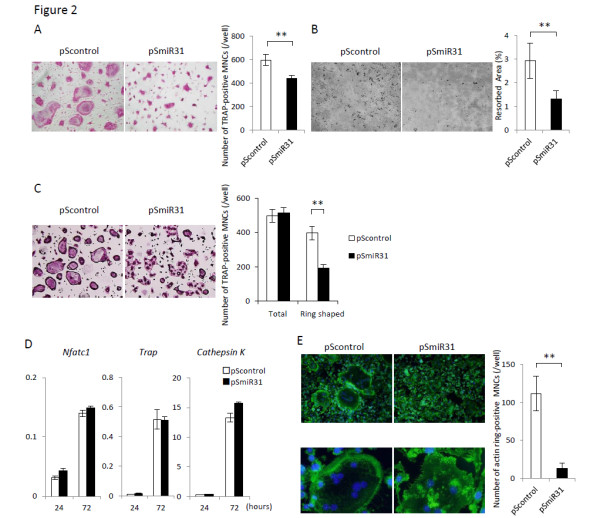Figure 2.

Osteoclasts generated under miR-31 inhibition show impaired osteoclastogenesis, bone resorption activities and actin ring formation. (A) Tartrate-resistant acid phosphatase (TRAP) staining of osteoclasts after transduction with retroviruses encoding antagomirs of miR-31 (pSmiR31) or control viruses (pScontrol). Osteoclasts were developed in the presence of receptor activator of nuclear factor κB ligand (RANKL) for 72 hours. Under conditions of miR-31 inhibition, although TRAP-positive multinucleated cells (MNCs) were formed, the frequency of ring-shaped mature osteoclastic cells was decreased. The number of TRAP-positive MNCs was decreased by miR-31 inhibition (n = 5/group). (B) Pit formation assay. Resorption lacunae were visualized in black by dark-field light microscopy. The resorbed area was decreased by miR-31 inhibition (n = 3/group). (C) TRAP staining of osteoclasts that were developed in the presence of RANKL for 120 hours. The total number of TRAP-positive MNCs that were generated under miR-31 inhibition was equivalent to that of control. The number of ring-shaped TRAP-positive MNCs that were generated under miR-31 inhibition was less than that of control (n = 5/group). (D) Real-time PCR analysis of osteoclasts generated under miR-31 inhibition. Values were normalized to glyceraldehyde 3-phosphate dehydrogenase expression. Expression levels of Nfatc1, Trap and Cathepsin K were not altered by miR-31 inhibitions (n = 3/group). (E) Actin-ring staining of osteoclasts. The number of actin ring-positive MNCs was decreased by miR-31 inhibition (upper panels) (n = 3/group). Podosome organization at the cell periphery was observed in control osteoclasts (lower left panel), but not when miR-31 was inhibited. Instead, small ring-shaped podosomes were observed (lower right panel). Green, Alexa 488 phalloidin; blue, 4',6-diamidino-2-phenylindole. **P < 0.01. Nfatc1, nuclear factor of activated T-cells, cytoplasmic, calcineurin-dependent 1.
